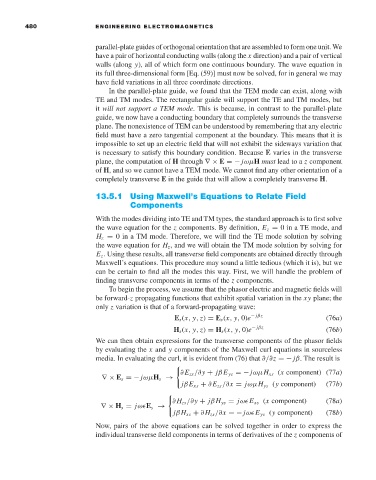Page 498 - Engineering Electromagnetics, 8th Edition
P. 498
480 ENGINEERING ELECTROMAGNETICS
parallel-plate guides of orthogonal orientation that are assembled to form one unit. We
have a pair of horizontal conducting walls (along the x direction) and a pair of vertical
walls (along y), all of which form one continuous boundary. The wave equation in
its full three-dimensional form [Eq. (59)] must now be solved, for in general we may
have field variations in all three coordinate directions.
In the parallel-plate guide, we found that the TEM mode can exist, along with
TE and TM modes. The rectangular guide will support the TE and TM modes, but
it will not support a TEM mode. This is because, in contrast to the parallel-plate
guide, we now have a conducting boundary that completely surrounds the transverse
plane. The nonexistence of TEM can be understood by remembering that any electric
field must have a zero tangential component at the boundary. This means that it is
impossible to set up an electric field that will not exhibit the sideways variation that
is necessary to satisfy this boundary condition. Because E varies in the transverse
plane, the computation of H through ∇× E =− jωµH must lead to a z component
of H, and so we cannot have a TEM mode. We cannot find any other orientation of a
completely transverse E in the guide that will allow a completely transverse H.
13.5.1 Using Maxwell’s Equations to Relate Field
Components
With the modes dividing into TE and TM types, the standard approach is to first solve
the wave equation for the z components. By definition, E z = 0inaTE mode, and
H z = 0ina TM mode. Therefore, we will find the TE mode solution by solving
the wave equation for H z , and we will obtain the TM mode solution by solving for
E z . Using these results, all transverse field components are obtained directly through
Maxwell’s equations. This procedure may sound a little tedious (which it is), but we
can be certain to find all the modes this way. First, we will handle the problem of
finding transverse components in terms of the z components.
To begin the process, we assume that the phasor electric and magnetic fields will
be forward-z propagating functions that exhibit spatial variation in the xy plane; the
only z variation is that of a forward-propagating wave:
E s (x, y, z) = E s (x, y, 0)e − jβz (76a)
H s (x, y, z) = H s (x, y, 0)e − jβz (76b)
We can then obtain expressions for the transverse components of the phasor fields
by evaluating the x and y components of the Maxwell curl equations in sourceless
media. In evaluating the curl, it is evident from (76) that ∂/∂z =− jβ. The result is
∂E zs /∂y + jβE ys =− jωµH xs (x component) (77a)
∇× E s =− jωµH s →
jβE xs + ∂E zs /∂x = jωµH ys (y component) (77b)
∂ H zs /∂y + jβH ys = jω E xs (x component) (78a)
∇× H s = jω E s →
jβH xs + ∂ H zs /∂x =− jω E ys (y component) (78b)
Now, pairs of the above equations can be solved together in order to express the
individual transverse field components in terms of derivatives of the z components of

